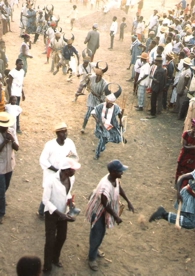
War-Dance (leelik)
Evans Akangyelewon Atuick
Are Final Funeral Rites in Buluk Really Expensive?
 |
|
War-Dance (leelik) |
Quite recently, some people had argued that performance of final funeral rites was a waste of resources, which could have
been channelled into the development of Buluk. They further argued that it was more worthwhile to contribute to development, hence, have one’s name immortalized on a concrete structure or project, rather than wasting resources on final funeral rites when our people are wallowing in poverty. To such persons, therefore, final funeral rites are expensive and not really necessary.
Such arguments, in my view, are unbulsalike, a fallacy of hasty conclusion and somewhat naïve (pardon my language). As a matter of fact, it is important to contextualize the performance of final funeral rites before one can reach a conclusion as to whether they are expensive and a waste of resources or not. As Prof. Miller (former Pro-VC, UDS, Tamale) always says, ‘we came to meet certain things and should leave them untouched, because our people hold them sacred and adhere to them.’ I dare to say that funerals are an essential part of Bulsa culture, the essence of which should never be questioned or reduced to mere shallow arguments.
First of all, let us understand the very basis (from a local Bulsa man’s perspective) for the performance of final funeral rites. The Bulsa, like any other Ghanaian tribe, believe that death is only a transition to the next world. The spirit of a dead man or woman remains restless until it is prepared for the final journey to the land of the dead (kpilung) and given the necessary “resources” to enable it rest peacefully. Based on the Bulsa worldview, a restless ancestral spirit can visit upon the living a myriad of calamites including ill-health, barrenness, poor harvest, death of livestock and even death of family members, amongst others. In fact, the performance of final funeral rites of the dead would not only prepare them for that final journey to kpilung (land of the dead) but also pave the way for good health, more children, good harvest and many more blessings on the family or compound. Therefore, from a Bulsa cultural perspective, the performance of final funeral rites is
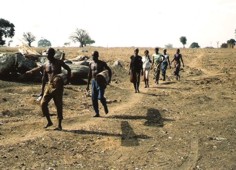 |
|
"Extended family funeral rites" (kuuna): The death-mat of a deceased relative is collected from a neighbouring compound |
very necessary. Indeed, for my uncle in Badomsa-Sinyangsa, Wiaga, channelling resources into so-called development projects instead of performing final funeral rites, which would bring to the family good health, bumper harvest and more children etc, does not make sense. The question is: What is development to our village folks when there is no peace of mind, good health and a bumper harvest?
Provided there are resources, no family head would allow funerals to accumulate overtime; the final rites could just be continued soon after the burial. In fact, it is not very uncommon to find many Bulsa families for whom it has become customary to continue with the final funeral rites soon after the burial of a corpse (kpie). However, delays in performance of such rites, to the best of my knowledge, are usually due to factors such as lack of resources, reluctance on the part of the custodian of family property to hand over (because once the rites are completed, control over family resources are transferred to another relation) or any other complex socio-cultural or spiritual issue, which must be resolved before any funeral rites can take place. Therefore, the so-called extended family final funeral rites (kuuna-funerals), i.e. rites for several dead persons performed at one time, that some persons spoke about, are usually done when resources are available and/or all other critical issues have been taken care of. Indeed, group final funeral rites allow the pulling of resources by several family members, hence, are less expensive than final funeral rites for one person (kuub-funeral).
| BULSA FUNERALS
Between death (kum) and the first funeral some important rituals are performed, e.g.: Kuub darika (announcement of death) Noai boka (ordeal of the mat) Tapili yika (hanging of the mat) The following list refers to funerals for male and female deceased. The elders (in the kusung-dok) decide if and when a day of rest (vuusim) is included.
First funeral celebrations (kuub) First day: kuub kpieng or kalika or tiaka yerika dai with nang(sa)-foba Second day: tika or kumu guka dai with kpaglika, leelisa (war-dances) and tiak juka Third day: kpaata dai (eating beans with a lot or oil) Fourth day: gbanta dai with siinika, cheri dungsa, parika kaabka, gbanta, arrival of the sons-in-law etc.
Second funeral celebrations (juka or ngomsika) First day: kpaama ngabika dai Second day: nyaata soka dai with bath of the widows... Third day: siira manika or lok tuilika or lokta juka dai with the burning of the quiver(s), the journey of the deceased to the land of the dead (kpilung) and the remarriage of the widows Fourth day: sinlengsa or daata nyuka dai with the double-bell-dance and the removal of the widows’ strings (miisa folika) F. Kröger |
Another reason why the performance of Bulsa final funeral rites is necessary is that the completion of such rites forms the basis for succession to positions or property. For instance, if a man was the head of the family until his death, his youngest son or his grandson would continue to act in that capacity until the final funeral rites are performed. This means that family property like lands and animals would remain in the care of such persons, with high risk of them selling everything to the detriment of the other family members and generations yet unborn. It is only after the performance of the final funeral rites that family or personal property can change hands by inheritance.
Moreover, mention could be made of the succession to chieftaincy titles. For instance, if the final funeral rites of our Great Chief Azantilow had not been successfully carried out, the people of Sandema could never have gone to the polls to elect a new chief. If one thinks, on face value, that the 20 cattle plus a donkey killed on the occasion of his funeral was expensive, then one is absolutely wrong. In fact, the Great Chief, apart from owning hundreds of cattle himself, fathered several children who are doing wonderfully well in their various professions. Indeed, it is well within their power to show how great and wealthy their father was while on earth, hence, the killing of several animals.
Nangsa-fobka-killing of an animal and using it as nang-foba (dead animal) symbolically detaches the dead from all worldly things. There is also the practice of kpaglika, the process of killing an extra animal (kpaglug) or a number of animals (kpaglugta) killed in addition to the nang-foba during the funeral rites in order to pacify other older ancestral spirits who were not given the same number and kind of animals as nang-foba during their final funeral rites. For instance, in the case of Nab Azantilow, the large number of cattle used for kpaglika, was to also provide for a number of his ancestors who were not given cattle during the funeral rites.
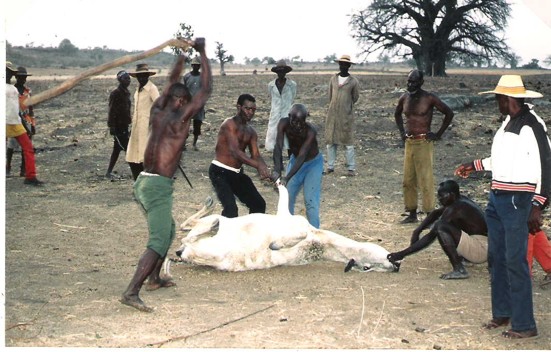 |
|
Nang-foba: A cow is killed with a cudgel |
Indeed, the number and sort of animals used as nang-foba/kpaglika during the final funeral rites of the Great Nab Azantilow were not only indicative of the wealth of the great chief, his forebears or the family but also incidentally provided a lot of meat to village folks, for the majority of who meat is a luxury. Also, we have to count the socio-cultural, religious and developmental implications of not having a paramount chief to lead and initiate development projects in our land. In this context, it would be gargantuanly ridiculous for one to conclude that the performance of such a funeral is a waste of resources that could have been channelled to development. Whose resources? And what kind of development are we talking about here?
Now to the vexed question of whether final funeral rites are expensive. Intrinsically, Buluk final funeral rites are not as expensive for the performer as some would want us to believe. First of all, during such rites, a chunk of the resources spent are derived from sons-in-law (chichambisa) of the dead person(s), whose final rites are being performed. Once, these in-laws are informed, by the link-man (san-yigma), it is incumbent on each of them to provide foodstuffs and refreshment (alcoholic and non-alcoholic beverages), which would be prepared by his wife and used to receive those who would accompany the husband to the compound on the climax of the funeral rites: on the 3rd day if funeral rites are only covering deceased male(s) or the 4th day if there is a deceased woman among the dead being mourned, in which case, they would have to rest (vuusim) for a day. If one fails to provide food, meat and drink for the upkeep of one’s own people, nobody would give such a husband and his entourage even water to drink on the funeral grounds!! Such husbands can provide whatever is within their means from the resources available to them, without being questioned by anybody. Therefore, if the husband of a daughter of the deceased is wealthy enough to be able to provide enough food (including so-called ‘almighty take-away’ [food packaged in portable disposable paper or rubber containers]) and drink, in order to receive people (including elders and drummers) who would come to help him mourn his in-law, what is wrong with that? In addition, each of them would bring a goat for the ‘tying of the pole’ (zangni bobka). Such animals are usually sold after the funeral rites to defray some of the costs incurred by the family during the rites.
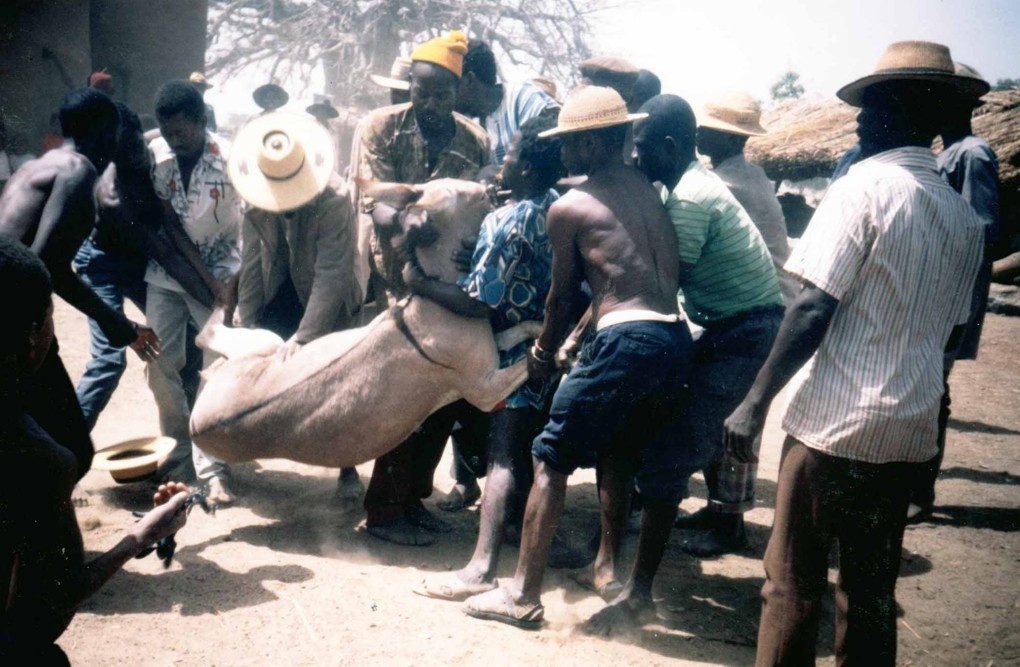 |
|
Kpagluk: A donkey is killed in front of the compound |
Moreover, children of the deceased would also prepare meals and provide refreshment for people who would come to help them mourn their father, including elders of the lineage, people from the maternal side, distant relations, friends etc. Some of such persons usually bring one thing or the other to help one give his father a befitting send off. Though receiving such visitors appears to be expensive, it is not actually so if one considers the social networking and capital it brings along. In line with the proverbial Bulsa hospitality, any visitor or person who comes to help one to do something is usually given refreshment, depending on the financial ability of the host. Even when people are poor, they strive very hard to make visitors comfortable, even to the extent that one could kill the only fowl he or she has. Against this backdrop, is there anything wrong in providing enough food and refreshment for relations, friends and sympathizers who came to help one mourn his father, if it is within one’s financial strength? There is absolutely nothing wrong if a person decides to receive his visitors in a certain way with his or her own resources. What is development to a person who has visitors and relations to entertain in a once-in-a-lifetime event, which would help immortalize the name of his or her father or uncle who is gone for good? Indeed, quite recently, the RLG (a Ghanaian mobile telecommunication company) boss, Roland Agambire, who hails from Sirigu, which is worse off than Buluk, paid an American musician, Chris Brown, one million dollars ($ 1,000,000, i.e. Ghc 2,000,000), for a one-hour music show. Just imagine what that money could have done to the land of Sirigu or even Upper East. Well, that is his money and he chose to spend it the way he wants. Who are we to question his motives?
Now let’s talk about killing animals during funerals. First and foremost, it is important for readers to know how and why this is done. As a matter of fact, this practice is in two forms namely nangsa-fobka (literally ‘beating/slapping of legs’) and kpaglika (literally ‘leaning against’ [the nang-foba]). On the one hand, the nangsa-fobka is the act of killing one or more animals to symbolically cleanse and detach the deceased from all worldly possessions/things he or she left behind on earth. In this case, the animal(s) is/are usually beaten to death and left on top of the rubbish dump (tampoi) for a day or two and can only be eaten by undertakers (vayaasa) or persons who have taken the magical ‘medicine’ (vayaam) of undertakers; vayaam is believed to be potent enough to prevent ghostly spirits from haunting one who has eaten it. On the other hand, the kpaglika is the practice of killing an additional animal (kpagluk) or a number of animals (kpaglugta) in addition to the nang-foba during the funeral rites in order to pacify other older ancestral spirits who were not given the same treatment during their final funeral rites. Thus, the kpaglika is only done in rare cases where an adult male who died and had the funeral rites performed long before the current funeral, was not given the type of animal(s) and the number of them used as nang-foba during the current kuub. For instance, if a man’s deceased father was not given a cow as nang-foba during his final funeral rites, and he himself dies and the rites are to be performed; if his family are wealthy enough to use a cow for his nang-foba, then another cow must be killed (kpaglug or kpaglugta - if many) and added for their deceased grandfather, who is the older of the two, hence, according to Bulsa custom, ought to be served/given anything before the younger one could be served or given his share of it. The kpaglug or kpaglugta is/are usually deposited at or close to the main entrance (nang-siuk) to the compound and can be eaten by any person regardless of his or her status (one does not need to be an undertaker or to have eaten vayaam to be able to eat the kpaglug/kpagluta).
This practice (nangsa-fobka), like I said earlier on, is also an opportunity for the family to show off the wealth left behind by the deceased or his forebears. Therefore, the deceased is given a portion of what he himself acquired or contributed to family wealth, as he or she embarks on that final journey to join the ancestors. The family can only kill what they have for a dead relative. If they have no cattle in the kraal, they could use anything ranging from a fowl to a goat or sheep. This depends on the sex and age of the deceased; a grown man deserves a bigger animal and just one animal could be slain for several deceased males (the eldest male could share it with his younger brothers or children). Depending on what has been done to family members who died earlier, the same would be done to new funerals (kuuna). For instance, if a cow was killed in past for dead male relations, then a matured deceased male with surviving children also deserves a cow, provided there are cattle in the kraal. I would use my own father’s (Hilary Atuick Asaghe) funeral rites as an example. According to custom, by his age and achievements, a bull was supposed to have been slain for him but eventually a ram was rather used for the nang-foba. They could not trace the family cattle in the bush, and in order not to delay the ceremony, I consented to the use of the ram. However, there were relations who were angry with the landlord because they thought my dad was too great a man to be demeaned that way. In fact, I even offered to provide a cow but they told me only family property could be used for such things. Had they agreed to use the cow I bought for the nangsa-fobka, then they can neither sell nor use family cattle for anything affecting the welfare of the family in future. In other words, they would always have to buy animals from outside for funerals or any other family activity.
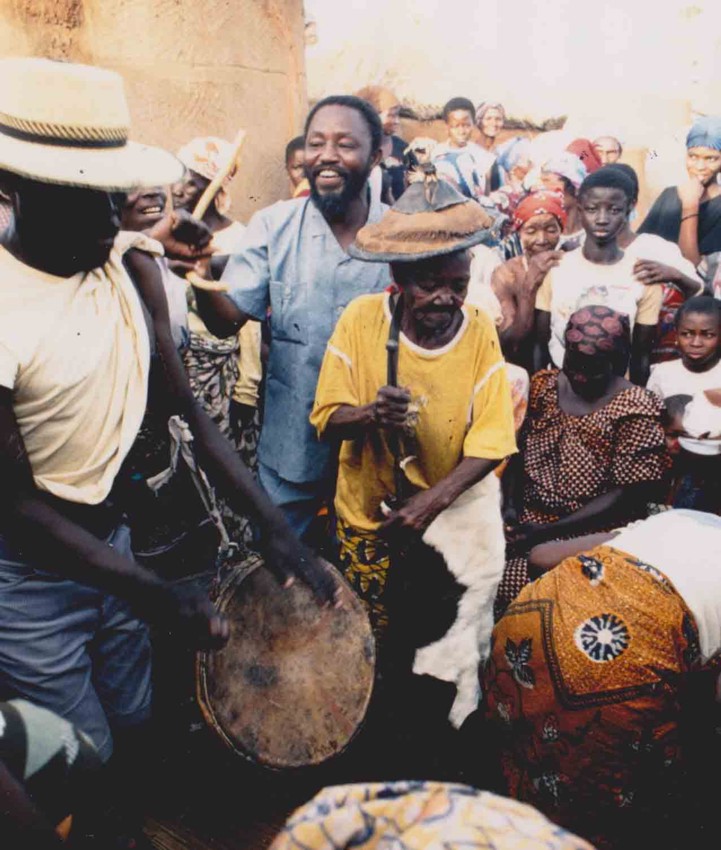 |
|
Cherika: An old woman "imitates" one of the deceased men (Behind her: Hillary Atuick, the author's father) |
Moreover, for breaking the custom, as one of the elders explained, henceforth, any male member who dies would be given a ram during the funeral rites, unless they kill two cows through the process of kpaglika; one as nang-foba for the one being mourned and one as kpagluk for my father, who was not given a cow during his funeral rites. Indeed, there is prestige in slaying a much bigger animal (cattle or several sheep) for dead relation; it shows how wealthy the dead man or his grandfather and the entire family are.
In conclusion, I don’t think that performance of funerals is unnecessary or too expensive as others are claiming. They are an essential part of our culture and identity as Bulsa people. Again, it is intellectually disingenuous to blame the performance of final funeral rites for the poverty of our people or the lack of development in our land. The real problem lies in the fact that the majority of us, the Bulsa Intelligentsia, are totally indifferent and unconcerned when it comes to supporting development projects in our motherland. For instance, the membership of BMY (a Bulsa internet discussion group) is now above 2000, but how many of us are really committed when it comes to supporting development projects in Buluk? What we really need is social re-engineering to help change our attitude towards investing in the development of Buluk. Again, if we are really serious about rallying Bulsa people for the development of Buluk, we should desist from making negative comments that affect the very sensibilities of our people and focus on helping to maintain our culture in its purest state since our culture gives us that unique identity. What we can do to help shape these rites is to eschew things such as the use of modern music gadgets, which destroy the purity of our traditions as Bulsa. I am one person who believes in leaving the purity of Bulsa cultural activities intact. Therefore, during my father’s final funeral rites, I refused to hire such “disco tech” to boom the village down, though I could afford their services. My word, the funeral was very great and traditional music of all kinds was on display throughout the period. My brothers and sisters, let’s join hands to do away with the foreign influence on our cultural activities such as funerals. What do you have to say?
Note: All photos were taken at the funeral of Anyenangdu (Anyenangdu Yeri, Wiaga-Sinyangsa-Badomsa) and some neighbours by Martin Striewisch (Essen).